Goodwill, Brands, and Restructuring: An Accounting Perspective
VerifiedAdded on 2022/11/10
|7
|1661
|385
Report
AI Summary
This report provides a comprehensive analysis of goodwill and brand accounting, examining the recognition criteria for goodwill, the treatment of brands as intangible assets, and the challenges associated with their reporting. It delves into the provisions of AASB 138/IAS 38, including initial and subsequent recognition, measurement, and disclosure requirements. The report also explores the implications of flawed investment strategies and the accounting treatment for restructuring as per AASB 137, including recognition criteria for restructuring provisions. The analysis covers situations when goodwill is recorded, the classification of goodwill (finite vs. infinite life), and the impact of goodwill impairment. The report also discusses the application of these accounting principles to practical scenarios, such as business combinations and restructurings, offering valuable insights into financial reporting practices. The report concludes with a summary of key findings and their implications for financial statement users.
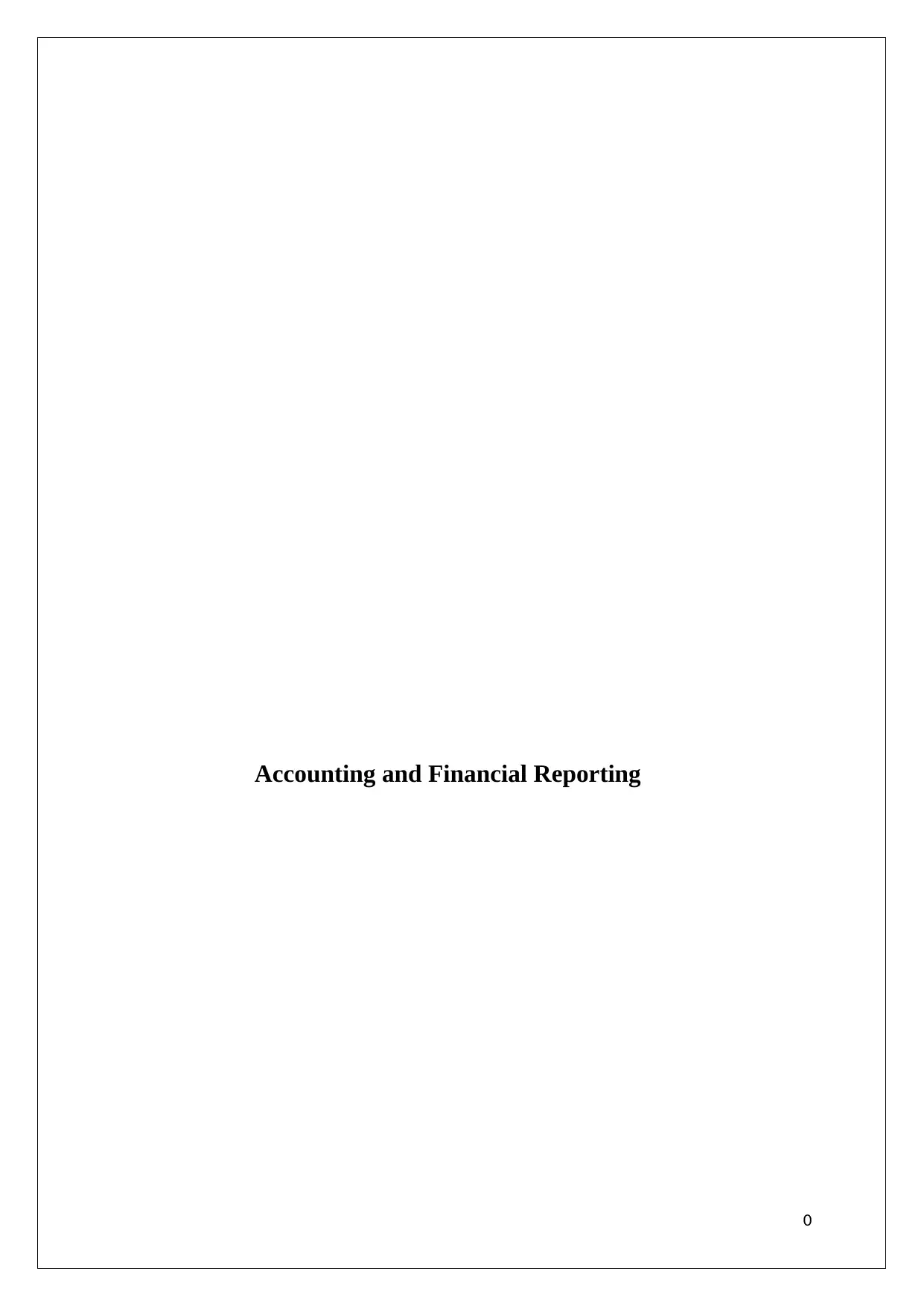
Accounting and Financial Reporting
0
0
Paraphrase This Document
Need a fresh take? Get an instant paraphrase of this document with our AI Paraphraser
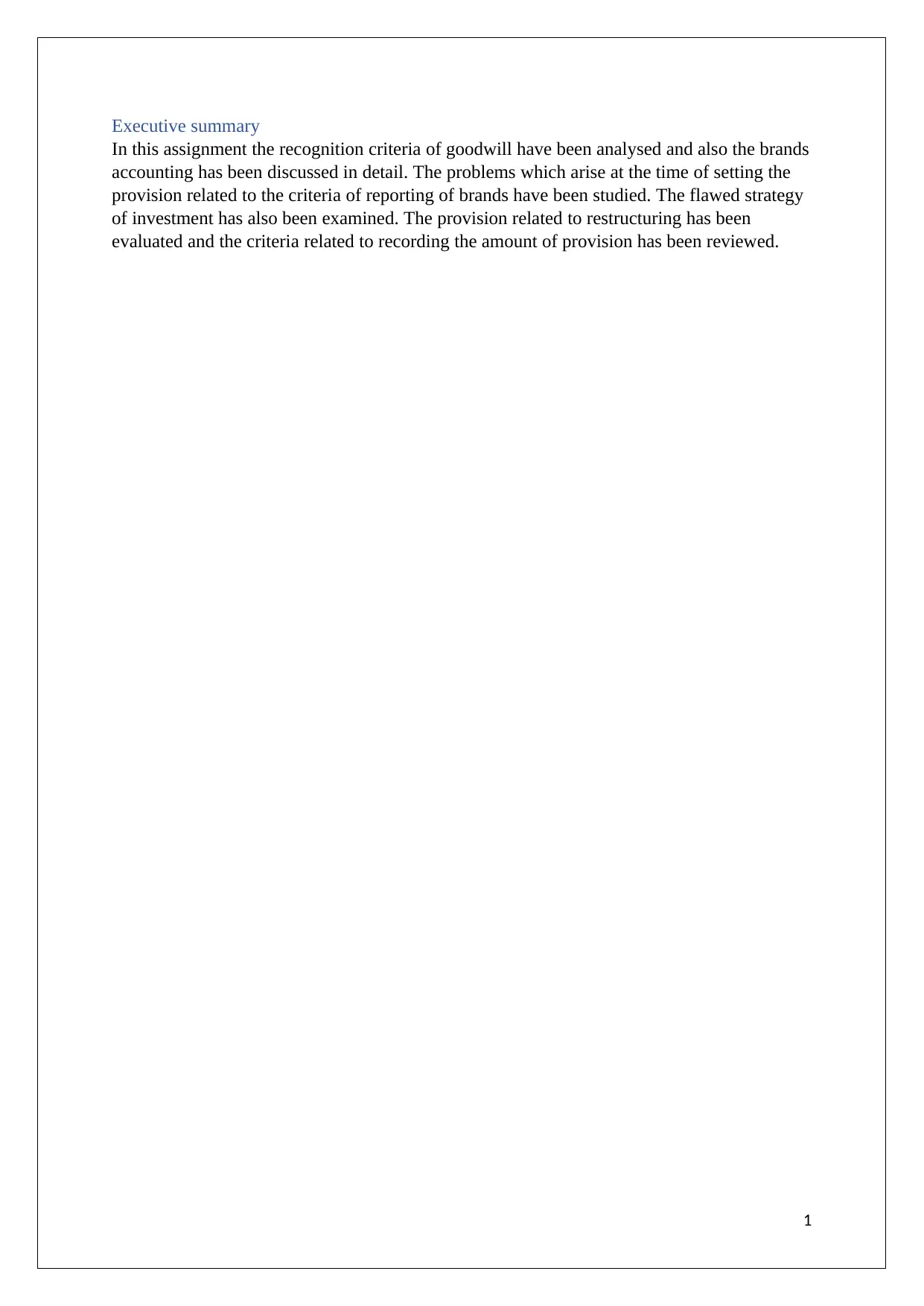
Executive summary
In this assignment the recognition criteria of goodwill have been analysed and also the brands
accounting has been discussed in detail. The problems which arise at the time of setting the
provision related to the criteria of reporting of brands have been studied. The flawed strategy
of investment has also been examined. The provision related to restructuring has been
evaluated and the criteria related to recording the amount of provision has been reviewed.
1
In this assignment the recognition criteria of goodwill have been analysed and also the brands
accounting has been discussed in detail. The problems which arise at the time of setting the
provision related to the criteria of reporting of brands have been studied. The flawed strategy
of investment has also been examined. The provision related to restructuring has been
evaluated and the criteria related to recording the amount of provision has been reviewed.
1
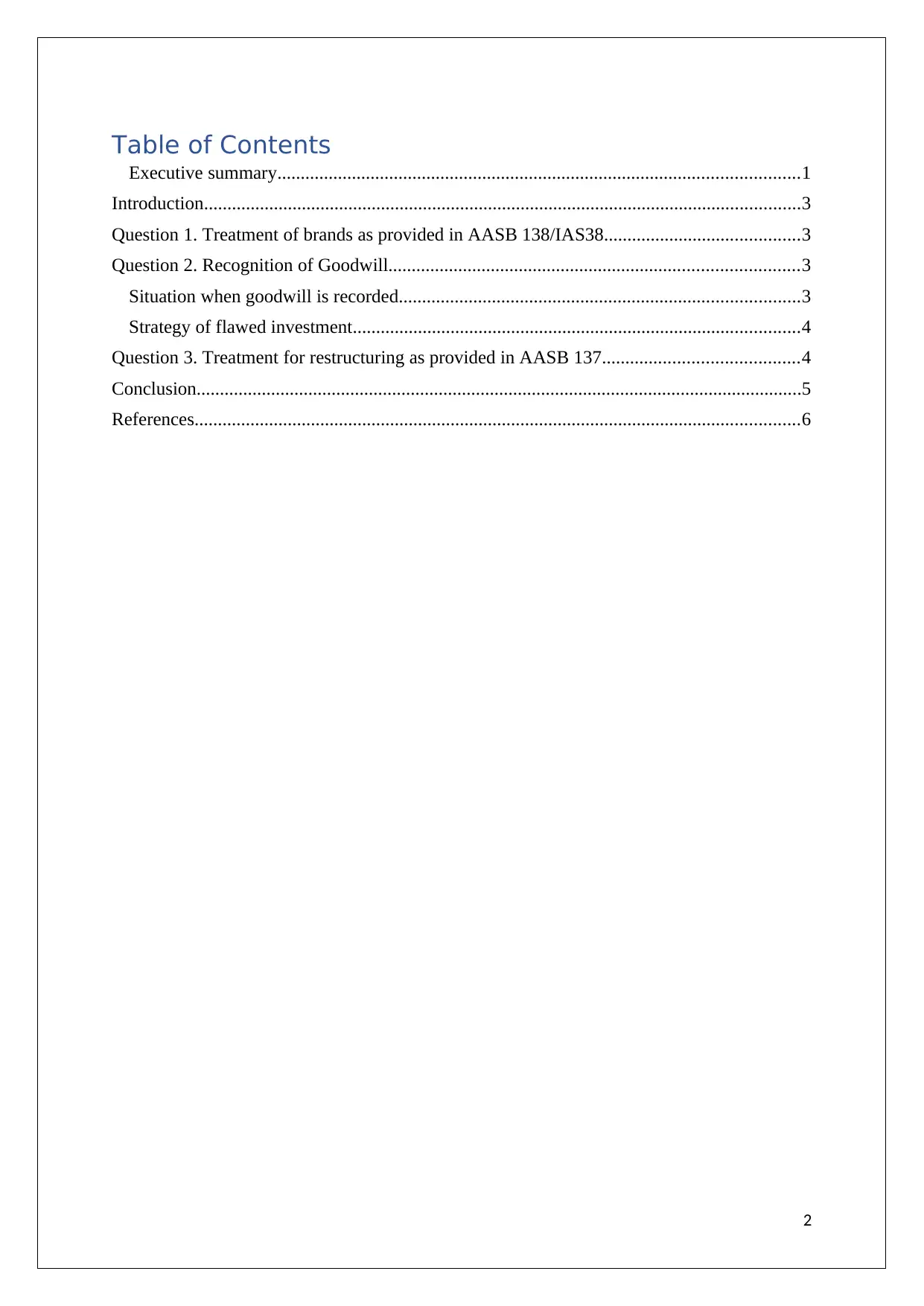
Table of Contents
Executive summary................................................................................................................1
Introduction................................................................................................................................3
Question 1. Treatment of brands as provided in AASB 138/IAS38..........................................3
Question 2. Recognition of Goodwill........................................................................................3
Situation when goodwill is recorded......................................................................................3
Strategy of flawed investment................................................................................................4
Question 3. Treatment for restructuring as provided in AASB 137..........................................4
Conclusion..................................................................................................................................5
References..................................................................................................................................6
2
Executive summary................................................................................................................1
Introduction................................................................................................................................3
Question 1. Treatment of brands as provided in AASB 138/IAS38..........................................3
Question 2. Recognition of Goodwill........................................................................................3
Situation when goodwill is recorded......................................................................................3
Strategy of flawed investment................................................................................................4
Question 3. Treatment for restructuring as provided in AASB 137..........................................4
Conclusion..................................................................................................................................5
References..................................................................................................................................6
2
⊘ This is a preview!⊘
Do you want full access?
Subscribe today to unlock all pages.

Trusted by 1+ million students worldwide
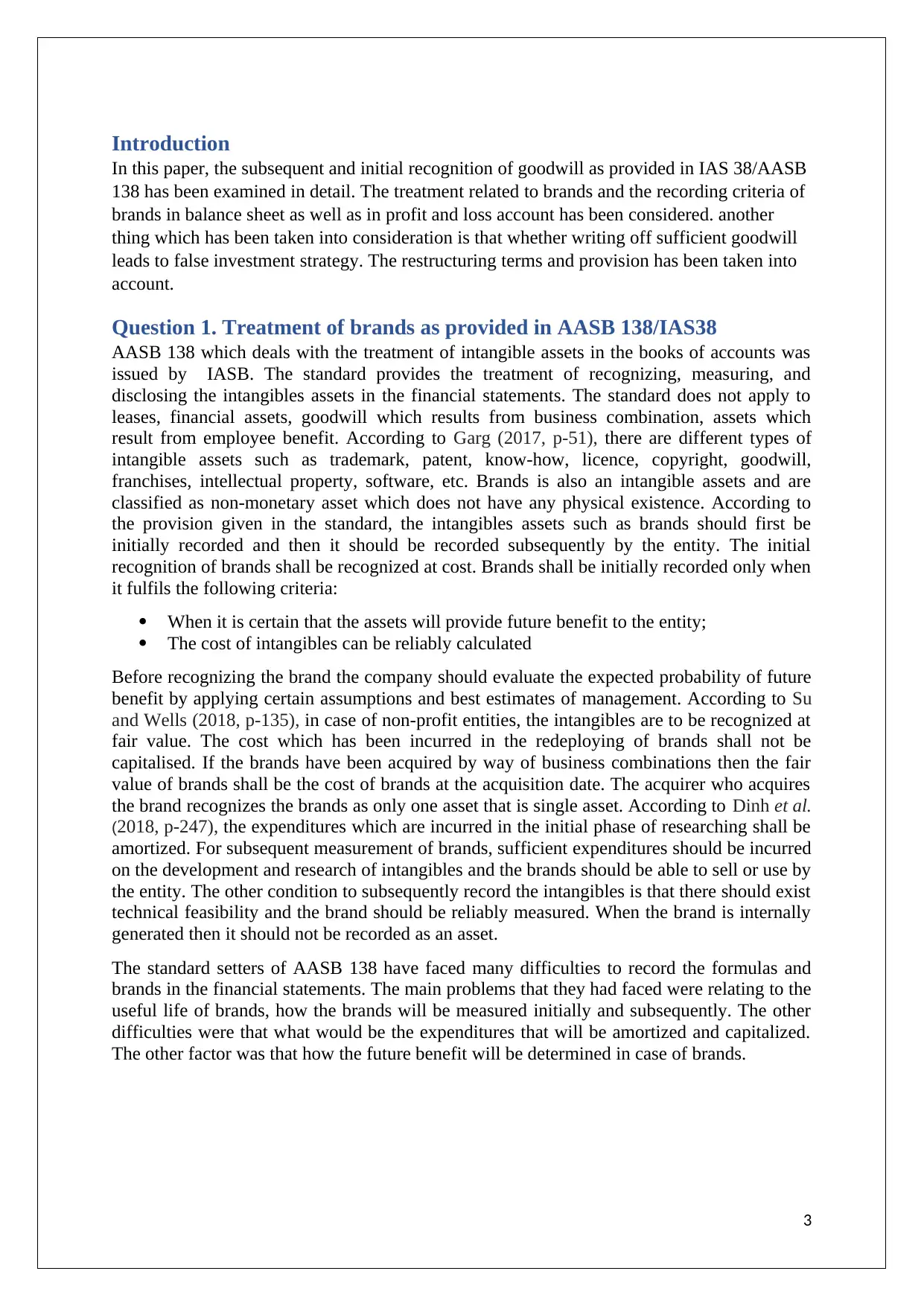
Introduction
In this paper, the subsequent and initial recognition of goodwill as provided in IAS 38/AASB
138 has been examined in detail. The treatment related to brands and the recording criteria of
brands in balance sheet as well as in profit and loss account has been considered. another
thing which has been taken into consideration is that whether writing off sufficient goodwill
leads to false investment strategy. The restructuring terms and provision has been taken into
account.
Question 1. Treatment of brands as provided in AASB 138/IAS38
AASB 138 which deals with the treatment of intangible assets in the books of accounts was
issued by IASB. The standard provides the treatment of recognizing, measuring, and
disclosing the intangibles assets in the financial statements. The standard does not apply to
leases, financial assets, goodwill which results from business combination, assets which
result from employee benefit. According to Garg (2017, p-51), there are different types of
intangible assets such as trademark, patent, know-how, licence, copyright, goodwill,
franchises, intellectual property, software, etc. Brands is also an intangible assets and are
classified as non-monetary asset which does not have any physical existence. According to
the provision given in the standard, the intangibles assets such as brands should first be
initially recorded and then it should be recorded subsequently by the entity. The initial
recognition of brands shall be recognized at cost. Brands shall be initially recorded only when
it fulfils the following criteria:
When it is certain that the assets will provide future benefit to the entity;
The cost of intangibles can be reliably calculated
Before recognizing the brand the company should evaluate the expected probability of future
benefit by applying certain assumptions and best estimates of management. According to Su
and Wells (2018, p-135), in case of non-profit entities, the intangibles are to be recognized at
fair value. The cost which has been incurred in the redeploying of brands shall not be
capitalised. If the brands have been acquired by way of business combinations then the fair
value of brands shall be the cost of brands at the acquisition date. The acquirer who acquires
the brand recognizes the brands as only one asset that is single asset. According to Dinh et al.
(2018, p-247), the expenditures which are incurred in the initial phase of researching shall be
amortized. For subsequent measurement of brands, sufficient expenditures should be incurred
on the development and research of intangibles and the brands should be able to sell or use by
the entity. The other condition to subsequently record the intangibles is that there should exist
technical feasibility and the brand should be reliably measured. When the brand is internally
generated then it should not be recorded as an asset.
The standard setters of AASB 138 have faced many difficulties to record the formulas and
brands in the financial statements. The main problems that they had faced were relating to the
useful life of brands, how the brands will be measured initially and subsequently. The other
difficulties were that what would be the expenditures that will be amortized and capitalized.
The other factor was that how the future benefit will be determined in case of brands.
3
In this paper, the subsequent and initial recognition of goodwill as provided in IAS 38/AASB
138 has been examined in detail. The treatment related to brands and the recording criteria of
brands in balance sheet as well as in profit and loss account has been considered. another
thing which has been taken into consideration is that whether writing off sufficient goodwill
leads to false investment strategy. The restructuring terms and provision has been taken into
account.
Question 1. Treatment of brands as provided in AASB 138/IAS38
AASB 138 which deals with the treatment of intangible assets in the books of accounts was
issued by IASB. The standard provides the treatment of recognizing, measuring, and
disclosing the intangibles assets in the financial statements. The standard does not apply to
leases, financial assets, goodwill which results from business combination, assets which
result from employee benefit. According to Garg (2017, p-51), there are different types of
intangible assets such as trademark, patent, know-how, licence, copyright, goodwill,
franchises, intellectual property, software, etc. Brands is also an intangible assets and are
classified as non-monetary asset which does not have any physical existence. According to
the provision given in the standard, the intangibles assets such as brands should first be
initially recorded and then it should be recorded subsequently by the entity. The initial
recognition of brands shall be recognized at cost. Brands shall be initially recorded only when
it fulfils the following criteria:
When it is certain that the assets will provide future benefit to the entity;
The cost of intangibles can be reliably calculated
Before recognizing the brand the company should evaluate the expected probability of future
benefit by applying certain assumptions and best estimates of management. According to Su
and Wells (2018, p-135), in case of non-profit entities, the intangibles are to be recognized at
fair value. The cost which has been incurred in the redeploying of brands shall not be
capitalised. If the brands have been acquired by way of business combinations then the fair
value of brands shall be the cost of brands at the acquisition date. The acquirer who acquires
the brand recognizes the brands as only one asset that is single asset. According to Dinh et al.
(2018, p-247), the expenditures which are incurred in the initial phase of researching shall be
amortized. For subsequent measurement of brands, sufficient expenditures should be incurred
on the development and research of intangibles and the brands should be able to sell or use by
the entity. The other condition to subsequently record the intangibles is that there should exist
technical feasibility and the brand should be reliably measured. When the brand is internally
generated then it should not be recorded as an asset.
The standard setters of AASB 138 have faced many difficulties to record the formulas and
brands in the financial statements. The main problems that they had faced were relating to the
useful life of brands, how the brands will be measured initially and subsequently. The other
difficulties were that what would be the expenditures that will be amortized and capitalized.
The other factor was that how the future benefit will be determined in case of brands.
3
Paraphrase This Document
Need a fresh take? Get an instant paraphrase of this document with our AI Paraphraser
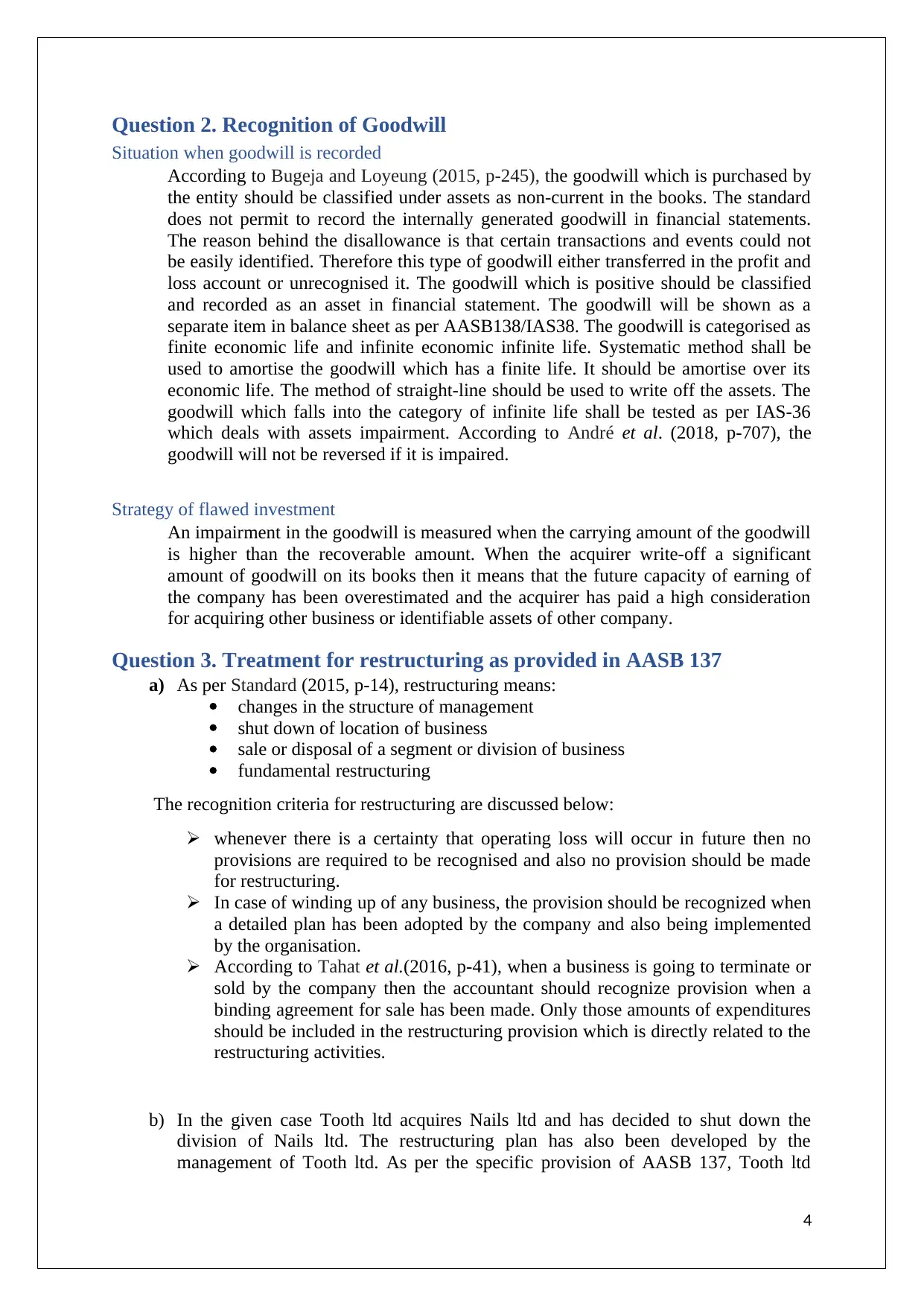
Question 2. Recognition of Goodwill
Situation when goodwill is recorded
According to Bugeja and Loyeung (2015, p-245), the goodwill which is purchased by
the entity should be classified under assets as non-current in the books. The standard
does not permit to record the internally generated goodwill in financial statements.
The reason behind the disallowance is that certain transactions and events could not
be easily identified. Therefore this type of goodwill either transferred in the profit and
loss account or unrecognised it. The goodwill which is positive should be classified
and recorded as an asset in financial statement. The goodwill will be shown as a
separate item in balance sheet as per AASB138/IAS38. The goodwill is categorised as
finite economic life and infinite economic infinite life. Systematic method shall be
used to amortise the goodwill which has a finite life. It should be amortise over its
economic life. The method of straight-line should be used to write off the assets. The
goodwill which falls into the category of infinite life shall be tested as per IAS-36
which deals with assets impairment. According to André et al. (2018, p-707), the
goodwill will not be reversed if it is impaired.
Strategy of flawed investment
An impairment in the goodwill is measured when the carrying amount of the goodwill
is higher than the recoverable amount. When the acquirer write-off a significant
amount of goodwill on its books then it means that the future capacity of earning of
the company has been overestimated and the acquirer has paid a high consideration
for acquiring other business or identifiable assets of other company.
Question 3. Treatment for restructuring as provided in AASB 137
a) As per Standard (2015, p-14), restructuring means:
changes in the structure of management
shut down of location of business
sale or disposal of a segment or division of business
fundamental restructuring
The recognition criteria for restructuring are discussed below:
whenever there is a certainty that operating loss will occur in future then no
provisions are required to be recognised and also no provision should be made
for restructuring.
In case of winding up of any business, the provision should be recognized when
a detailed plan has been adopted by the company and also being implemented
by the organisation.
According to Tahat et al.(2016, p-41), when a business is going to terminate or
sold by the company then the accountant should recognize provision when a
binding agreement for sale has been made. Only those amounts of expenditures
should be included in the restructuring provision which is directly related to the
restructuring activities.
b) In the given case Tooth ltd acquires Nails ltd and has decided to shut down the
division of Nails ltd. The restructuring plan has also been developed by the
management of Tooth ltd. As per the specific provision of AASB 137, Tooth ltd
4
Situation when goodwill is recorded
According to Bugeja and Loyeung (2015, p-245), the goodwill which is purchased by
the entity should be classified under assets as non-current in the books. The standard
does not permit to record the internally generated goodwill in financial statements.
The reason behind the disallowance is that certain transactions and events could not
be easily identified. Therefore this type of goodwill either transferred in the profit and
loss account or unrecognised it. The goodwill which is positive should be classified
and recorded as an asset in financial statement. The goodwill will be shown as a
separate item in balance sheet as per AASB138/IAS38. The goodwill is categorised as
finite economic life and infinite economic infinite life. Systematic method shall be
used to amortise the goodwill which has a finite life. It should be amortise over its
economic life. The method of straight-line should be used to write off the assets. The
goodwill which falls into the category of infinite life shall be tested as per IAS-36
which deals with assets impairment. According to André et al. (2018, p-707), the
goodwill will not be reversed if it is impaired.
Strategy of flawed investment
An impairment in the goodwill is measured when the carrying amount of the goodwill
is higher than the recoverable amount. When the acquirer write-off a significant
amount of goodwill on its books then it means that the future capacity of earning of
the company has been overestimated and the acquirer has paid a high consideration
for acquiring other business or identifiable assets of other company.
Question 3. Treatment for restructuring as provided in AASB 137
a) As per Standard (2015, p-14), restructuring means:
changes in the structure of management
shut down of location of business
sale or disposal of a segment or division of business
fundamental restructuring
The recognition criteria for restructuring are discussed below:
whenever there is a certainty that operating loss will occur in future then no
provisions are required to be recognised and also no provision should be made
for restructuring.
In case of winding up of any business, the provision should be recognized when
a detailed plan has been adopted by the company and also being implemented
by the organisation.
According to Tahat et al.(2016, p-41), when a business is going to terminate or
sold by the company then the accountant should recognize provision when a
binding agreement for sale has been made. Only those amounts of expenditures
should be included in the restructuring provision which is directly related to the
restructuring activities.
b) In the given case Tooth ltd acquires Nails ltd and has decided to shut down the
division of Nails ltd. The restructuring plan has also been developed by the
management of Tooth ltd. As per the specific provision of AASB 137, Tooth ltd
4
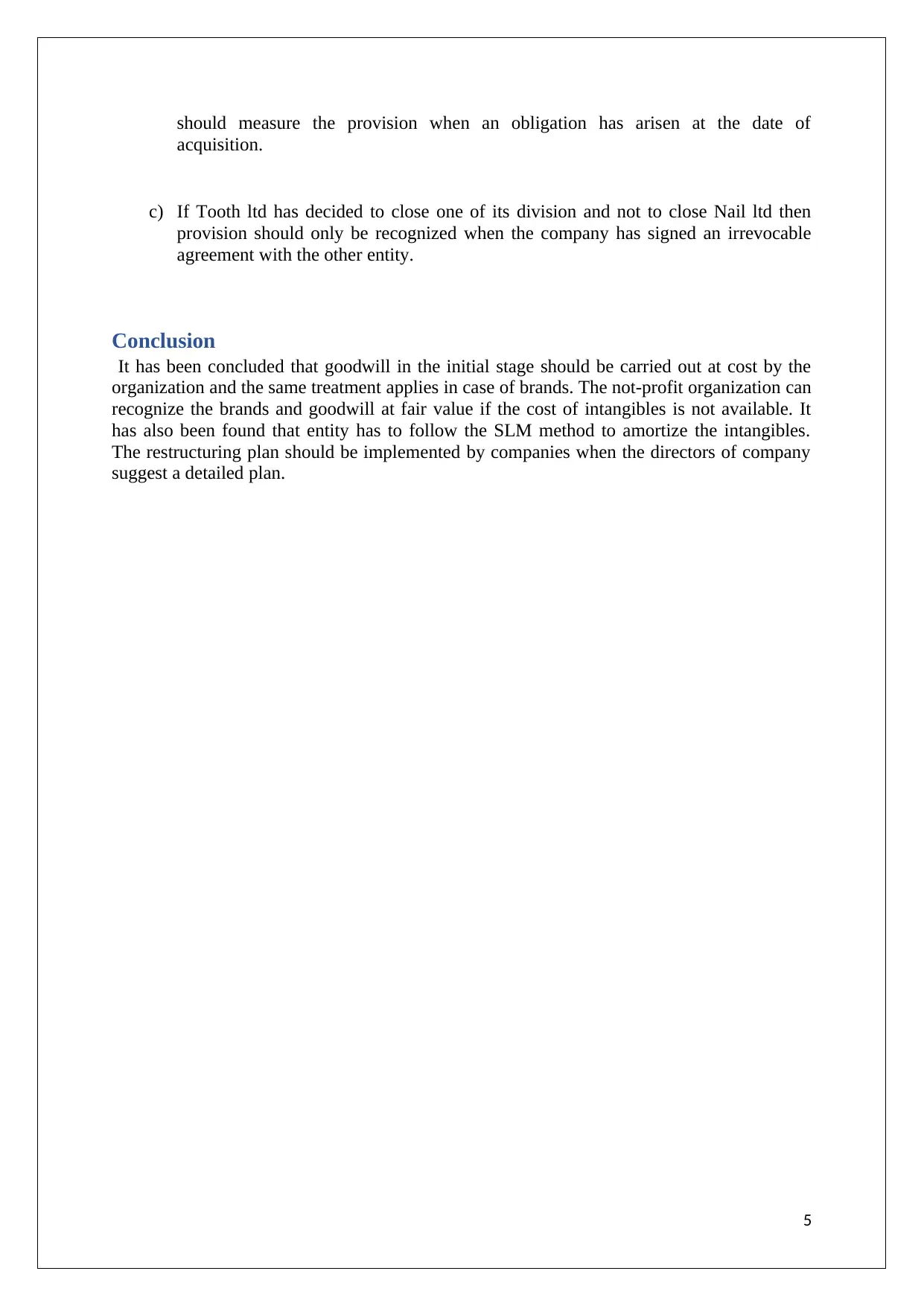
should measure the provision when an obligation has arisen at the date of
acquisition.
c) If Tooth ltd has decided to close one of its division and not to close Nail ltd then
provision should only be recognized when the company has signed an irrevocable
agreement with the other entity.
Conclusion
It has been concluded that goodwill in the initial stage should be carried out at cost by the
organization and the same treatment applies in case of brands. The not-profit organization can
recognize the brands and goodwill at fair value if the cost of intangibles is not available. It
has also been found that entity has to follow the SLM method to amortize the intangibles.
The restructuring plan should be implemented by companies when the directors of company
suggest a detailed plan.
5
acquisition.
c) If Tooth ltd has decided to close one of its division and not to close Nail ltd then
provision should only be recognized when the company has signed an irrevocable
agreement with the other entity.
Conclusion
It has been concluded that goodwill in the initial stage should be carried out at cost by the
organization and the same treatment applies in case of brands. The not-profit organization can
recognize the brands and goodwill at fair value if the cost of intangibles is not available. It
has also been found that entity has to follow the SLM method to amortize the intangibles.
The restructuring plan should be implemented by companies when the directors of company
suggest a detailed plan.
5
⊘ This is a preview!⊘
Do you want full access?
Subscribe today to unlock all pages.

Trusted by 1+ million students worldwide
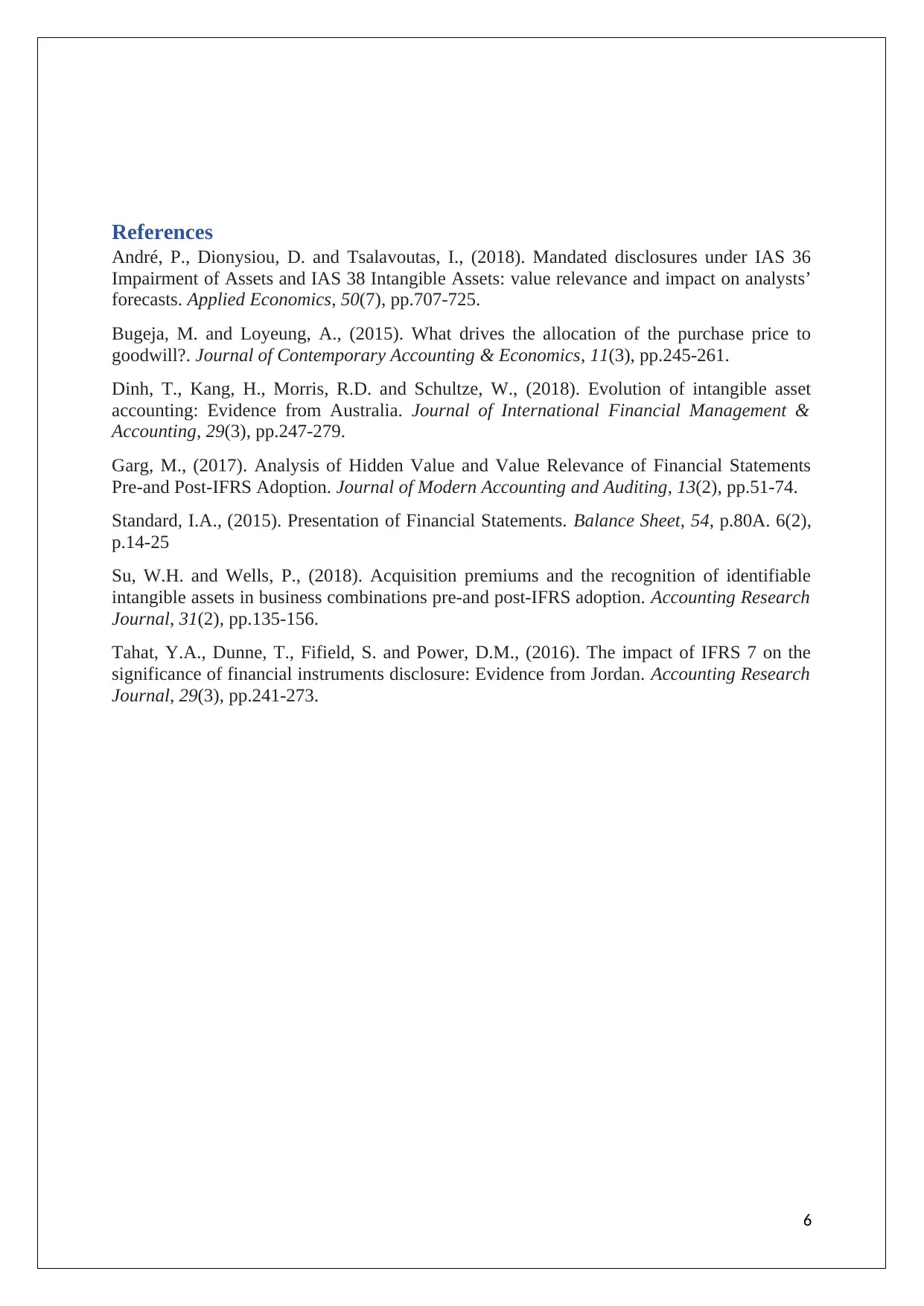
References
André, P., Dionysiou, D. and Tsalavoutas, I., (2018). Mandated disclosures under IAS 36
Impairment of Assets and IAS 38 Intangible Assets: value relevance and impact on analysts’
forecasts. Applied Economics, 50(7), pp.707-725.
Bugeja, M. and Loyeung, A., (2015). What drives the allocation of the purchase price to
goodwill?. Journal of Contemporary Accounting & Economics, 11(3), pp.245-261.
Dinh, T., Kang, H., Morris, R.D. and Schultze, W., (2018). Evolution of intangible asset
accounting: Evidence from Australia. Journal of International Financial Management &
Accounting, 29(3), pp.247-279.
Garg, M., (2017). Analysis of Hidden Value and Value Relevance of Financial Statements
Pre-and Post-IFRS Adoption. Journal of Modern Accounting and Auditing, 13(2), pp.51-74.
Standard, I.A., (2015). Presentation of Financial Statements. Balance Sheet, 54, p.80A. 6(2),
p.14-25
Su, W.H. and Wells, P., (2018). Acquisition premiums and the recognition of identifiable
intangible assets in business combinations pre-and post-IFRS adoption. Accounting Research
Journal, 31(2), pp.135-156.
Tahat, Y.A., Dunne, T., Fifield, S. and Power, D.M., (2016). The impact of IFRS 7 on the
significance of financial instruments disclosure: Evidence from Jordan. Accounting Research
Journal, 29(3), pp.241-273.
6
André, P., Dionysiou, D. and Tsalavoutas, I., (2018). Mandated disclosures under IAS 36
Impairment of Assets and IAS 38 Intangible Assets: value relevance and impact on analysts’
forecasts. Applied Economics, 50(7), pp.707-725.
Bugeja, M. and Loyeung, A., (2015). What drives the allocation of the purchase price to
goodwill?. Journal of Contemporary Accounting & Economics, 11(3), pp.245-261.
Dinh, T., Kang, H., Morris, R.D. and Schultze, W., (2018). Evolution of intangible asset
accounting: Evidence from Australia. Journal of International Financial Management &
Accounting, 29(3), pp.247-279.
Garg, M., (2017). Analysis of Hidden Value and Value Relevance of Financial Statements
Pre-and Post-IFRS Adoption. Journal of Modern Accounting and Auditing, 13(2), pp.51-74.
Standard, I.A., (2015). Presentation of Financial Statements. Balance Sheet, 54, p.80A. 6(2),
p.14-25
Su, W.H. and Wells, P., (2018). Acquisition premiums and the recognition of identifiable
intangible assets in business combinations pre-and post-IFRS adoption. Accounting Research
Journal, 31(2), pp.135-156.
Tahat, Y.A., Dunne, T., Fifield, S. and Power, D.M., (2016). The impact of IFRS 7 on the
significance of financial instruments disclosure: Evidence from Jordan. Accounting Research
Journal, 29(3), pp.241-273.
6
1 out of 7
Related Documents
Your All-in-One AI-Powered Toolkit for Academic Success.
+13062052269
info@desklib.com
Available 24*7 on WhatsApp / Email
![[object Object]](/_next/static/media/star-bottom.7253800d.svg)
Unlock your academic potential
Copyright © 2020–2025 A2Z Services. All Rights Reserved. Developed and managed by ZUCOL.





